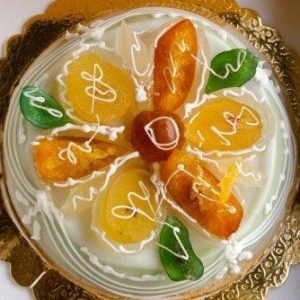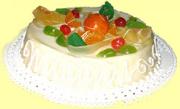
Introduction to Cassata Siciliana
There are many myths about the Cassata Siciliana. It is described in many recipes as a wedding cake, made with whipped cream, and with emphasis to the fact that it is very rich, and offensively sweet. The truth is that a well-made cassata is a harmonious blend of different tastes and aromas, with a balanced freshness of the lemony icing and the delicate savor of ricotta cream.
Cassata is the most celebrated Sicilian dessert and it is the classic Sicilian Easter Cake. Easter comes around the time of the vernal equinox, which occurs on March 20 or 21; it indicates the coming of spring in the Northern Hemisphere. It coincides with the Roman pagan celebration of Ceres, Demeter for the Greeks, the goddess of fertility who blesses and helps to produce the fruits of the earth; cakes were offered for the occasion to the goddess; they were made with an outer crust of flour and honey and stuffed with sweetened ricotta.
To celebrate weddings, this cake was baked and wrapped in laurel leaves.Many scholars claim the Cassata was introduced in Sicily by the Arabs in the ninth century, deriving the name Cassata from the Arabic quasat: on this subject, it is very hard to come to a sure and positive conclusion and any theory could be as valid as any other speculation. In fact the Arabs contributed to the Sicilian cooking, including many desserts; however, their influence has been greatly overstated. They introduced sugar to Sicily, making it possible to transform the almond paste, originally sweetened with honey, into marzipan, the Pasta Reale. They introduced many new spices from the Orient, gave Saracen names to some Sicilian dishes, made contributions to agriculture by creating small farms individually owned and introduced a modern irrigation system.
Going back to Cassata… It is more reasonable to conclude that the word cassata does not derive from the Arabic word qas’at, meaning a small box or incidentally it could have derived from the Latin word capsa which means case, chest or box which in vulgar Latin morphed into cassa, hence the word cassata; or else and more probable, since the ricotta cheese is the main ingredient in the cassata, this word could derive from caseus which means cheese. Furthermore, because Sicilian cooks employed by the elites of the Roman high society living in Sicily and in Rome, prepared a type of bread stuffed with honey, fresh cheese and covered with fresh fruits to offer to Ceres, the goddess of fertility around what is now, Easter time, and being Latin the language used by the Sicilian cooks, the word caseus was distorted in cacio, casia and Cassata.
This kind of cake goes back before the Romans Empire: Sicilian cooks were making a similar pastry in Magna Grecia, for the Greeks living in Sicily, to offer to their goddess Demeter to gain her blessings to the land and to bring new life into their families. The truth is that Cassata is as Sicilian as the apple pie is American. Later candied citron was added to the filling along with chocolate pieces when it was introduced from America. This type of cassata is now known as Cassata al Forno or baked cassata.
The classic Cassata Siciliana as it is known today was introduced in the 19th century by Signor Guli’, a famous pasticciere and owner of the homonymous pastry shop in Corso Vittorio Emanuele in Palermo. One of the members of the prominent Florio family asked him to make some exceptional cakes that would not turn acrid so they could be shipped to their friends as a different sweet and delicious gift: Mr. Guli’ successfully made what is today considered the epitome of the Sicilian dessert as well as the cake to celebrate Easter and holidays, not only on Sicilian tables.

The main ingredients of the original and classic Cassata are sponge cake (pan di Spagna) and a filling made with ricotta sweetened with a small amount of sugar or honey, fragrant with cinnamon, with a hint of vanilla and enriched with diced citron and orange. The outside is covered with a light layer of glaze, prepared with confectionary sugar and lemon juice to counterbalance the sweetness of the cake and as a final touch, it is decorated with multicolored candied whole and sliced fruits. Special round molds are used, with the side 2 ½ inches high, inclined to the outside about 15 degrees, to give that particular and characteristic shape. After the Cassata is made, it must be stored for a few hours or overnight, to allow the aromas of the ricotta to blend with the sponge, and then it can be completed and decorated.

The Cassata recipes I am posting are:
